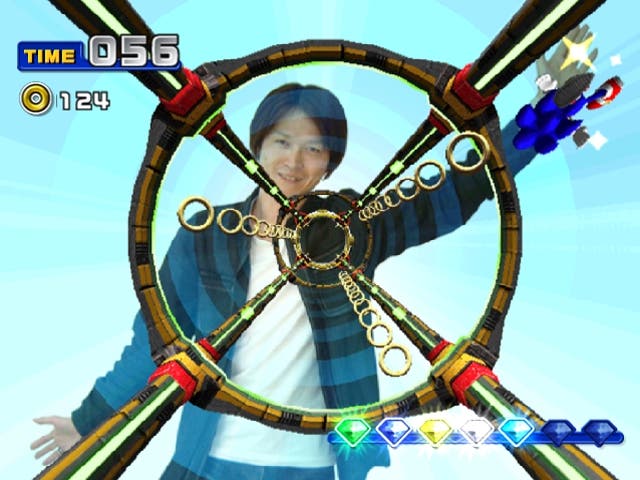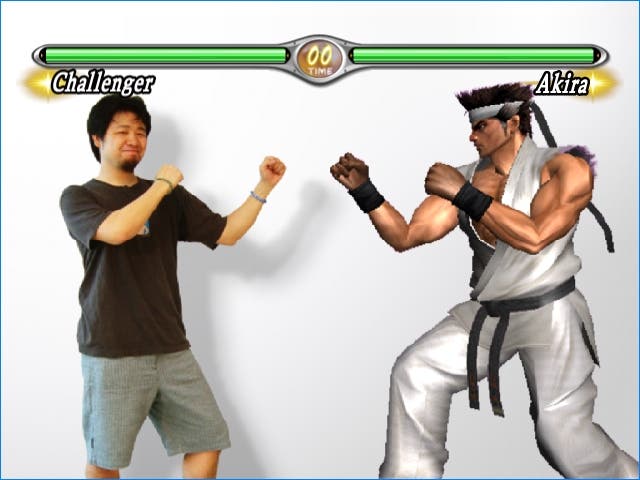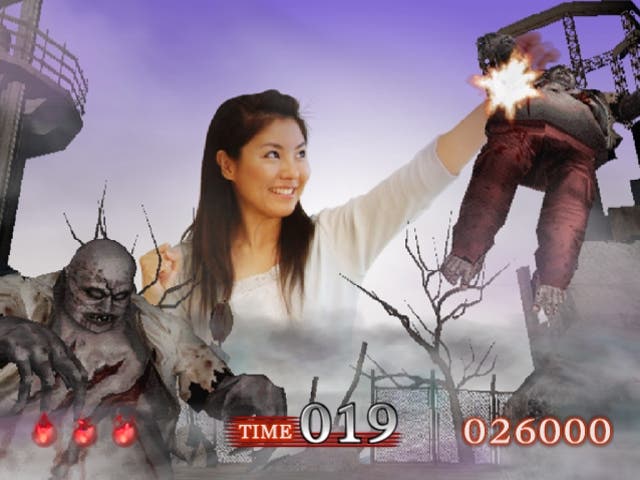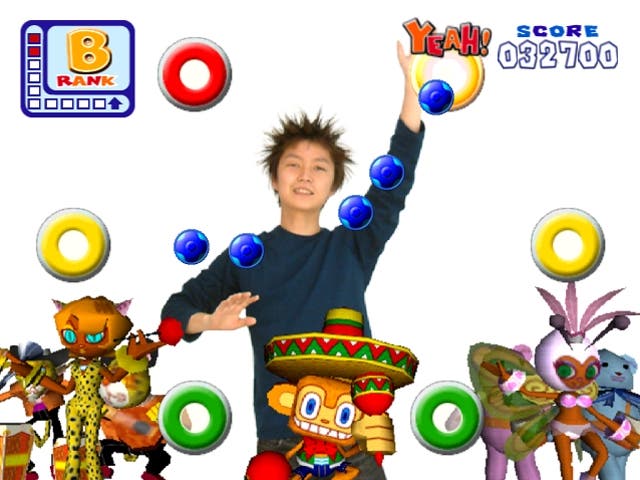SEGA SuperStars
EyeToy? It's for kids and casual post-pub novelty entertainment, right? Not in the hands of Sonic Team.
EyeToy may have enjoyed a meteoric rise to fame in Europe, but ever since we first got our hands on it last summer we've been dogged by a nagging suspicion that it's done so largely by virtue of novelty. When we look back at the games we've played using that little USB webcam, it's clear that they reject much of what we love about the medium - most notably the importance of skill, progressive challenge and replay value - in favour of novelty tasks that rely partly on the player's excitement at seeing him or herself on the screen, and partly on an array of cuddly sound effects and wackiness to attract attention.
To our minds, it's one of the reasons EyeToy: Groove met with a poor reception compared to Play - the novelty was starting to wear off, and Sony didn't have a particularly good game to follow up and convert the curious customer into a loyal follower. (Plus, you can't make the Cheeky Girls into entertainment no matter how much you've had to drink.)
EyeToy: Game-Play?

With this in mind, we have to be honest and admit that we were a little sceptical when we first caught wind of Sega's decision to make an EyeToy game starring a range of its own characters. Wouldn't this just be more of the same? Wishi Washi with a foamed up Ulala? Keepie-uppies with some bloke from Virtua Striker? Virtua Fighter dressed up as a Boxing clone? Had Sega lost sight of its gaming principles and simply decided to cash in? Attempting to combine the popularity of a few of its best-known characters with a new peripheral boasting a massive installed base?
Whether or not that played a part somewhere in the company's process, in the hands of Sonic Team it was never going to end up that way. Sonic Team, after all, specialise in videogames rather than novelty. When they harness a seemingly bizarre peripheral, the result is always a game that we can cherish partly for its quintessentially innovative approach, but mainly because it delivers a progressively rewarding experience that requires technique and a certain gaming mindset to enjoy. Just look to the analogue pad in NiGHTS, or the shakers for Samba De Amigo for proof of that.
Although we've only played rough cuts of a pair of the 12 or so games that will make up Sega SuperStars, it's clearer now than ever that Sonic Team is approaching this project in the right way. In the words of a fellow journalist with whom we shared our SuperStars session, "an EyeToy game with Sega characters is the reason to give a s**t". At this point, we couldn't agree more.
Sonic boom

It's a view borne out for us in one single aspect of the Sonic the Hedgehog mini-game on display at E3 this year more than any other: we are not the character. In every EyeToy game we've seen to date, the idea is to make the vision of the player the centre of attention, both for the gamer at the controls and for the people hopefully loafing on beanbags and chortling at your flailing limbs.
But Sonic is different. Here we play as Sonic - and just happen to control him using our arms rather than your control pad. The challenge is to direct the spiky blue blur along the inside of a tube at high speed, navigating past spiked balls, collecting lines of rings and hitting boost pads to increase speed and beat the time limit, and most importantly attempting to gather the seven chaos emeralds per stage needed to advance to the next one.
By the end of the level it's immediately distinguishable from other EyeToy games in another key respect - we haven't won. We weren't simply going for a high score - we were asked to do something to progress, and due to our lack of experience with the controls and a bit of ill fortune, we haven't managed to pick up all seven of the chaos emeralds (successful collection of each indicated in the bottom-right corner of the screen, and met with a nice change of tube colour), and we have to go again.
Pipe dreaming

At this stage, some of the difficulty does owe to the fact that the game is unfinished. There's a bit of clipping in the distance which means that spiked balls and chaos emeralds are probably visible a lot later in the day than they will be in the final version, and the slight delay between action and the game's reaction means that we sometimes miss rings and emeralds or bash into spiked balls when we shouldn't. But the inertia sometimes works to our favour too - as does the way Sonic snaps to eight obvious paths on the inside of the tube, rather than moving completely freeform.
As we play, we change Sonic's path by moving our hands from one point on the tube to the next in an arcing motion - a bit like moving the hands on a giant clock with the palm of a hand - and although it obviously needs a little sharpening up, there's a sense that we're playing a game rather than just completing a novel task.
It was the desire to get all seven emeralds and reach the next stage (of which there will be around five per mini-game) that drove us to continue playing, rather than the previous assumption that 'being on TV' plus 'waving arms' equals 'innovative entertainment'. We hardly ever went back to some of the original Play mini-games after the first go, but here we wound up begging for another turn, only giving up when the atmosphere inside the room coupled with our lack of physical fitness started to give way to body odour...
The House that EyeToy built

Believe it or not, House Of The Dead, the only other mini-game in the E3 demo, shares some of Sonic's traits. Again, it's a question of beating the level to get to the next one - this time by whacking bats and zombies (often multiple times) before they can hit us, and trying to avoid hitting innocent bystanders like a little woman holding her head in her hands in terror. Well, she is in our armpit's line of fire. If we take three hits from the zombies (or hit the woman and get slapped for it enough), we have to start the stage again. Again, as with all the other titles in the package, there should be a few levels to work through, and although nothing was said of the bonuses for completing them without taking a hit, this very clearly being a Sonic Team game we can't help but suspect there will be unlockables for dedicated gamers.
In other respects, House of the Dead is a lot like the light gun game from whence it came. On each screen we take on a group of enemies, thrashing at them with our hands and elbows as they lurch closer and closer motivated by the possibility of landing a deadly blow. When we hit them, a bloody slash-mark appears over them and the game coughs up a satisfying 'thwack!' effect - particularly enjoyable when we manage to land three quick hits in succession. Once we've dispensed with the enemies in the current area, the game moves forward in the same way it does in the light gun equivalent, and we're faced with new challenges, all the while we're impressed by the authentic HOTD visuals and spooky music, and compelled to go back and have another turn when we shamefully fail to complete the level on the first attempt.
Feels just like a SuperStar
When we do beat House of the Dead though, with Sonic already behind us, and we're sitting back and trying to pretend we're not puffed out, there is a feeling that the rest of the package has a lot to live up to. Of course there's still the question of what actually makes up the rest the line-up, although Sega's placeholder graphic for the E3 demo (a montage of the developer's characters and franchises - with Virtua Striker, Space Channel 5, HOTD, Sonic, Billy Hatcher, Crazy Taxi, NiGHTS, Monkey Ball, Virtua Fighter, Samba de Amigo and ChuChu Rocket all represented) is bound to be heralded by some as the answer, despite a spokesperon's claim that "they're potentials" rather than the real thing. There's also the question of how responsive the Sonic game can be made, given that it relies on reactions at speed in a way that previous EyeToy games haven't.
In other words, we still have some very real concerns despite our obvious enthusiasm, but, while playing these games and weighing up the possibilities of the Sonic and Samba titles in particular, there's a sense that when SuperStars launches towards the end of 2004 EyeToy owners will finally have something else worth owning, and that those originally sceptical of the concept will finally have something that lives up to their gaming expectations.
In the original SuperStars announcement, Yuji Naka paid tribute to Sony for developing "a whole new way of interfacing with a game," but in the end it's Naka and his Sonic Team to whom we should pay tribute - because they appear to be on the verge of delivering a whole new way of developing EyeToy games.

